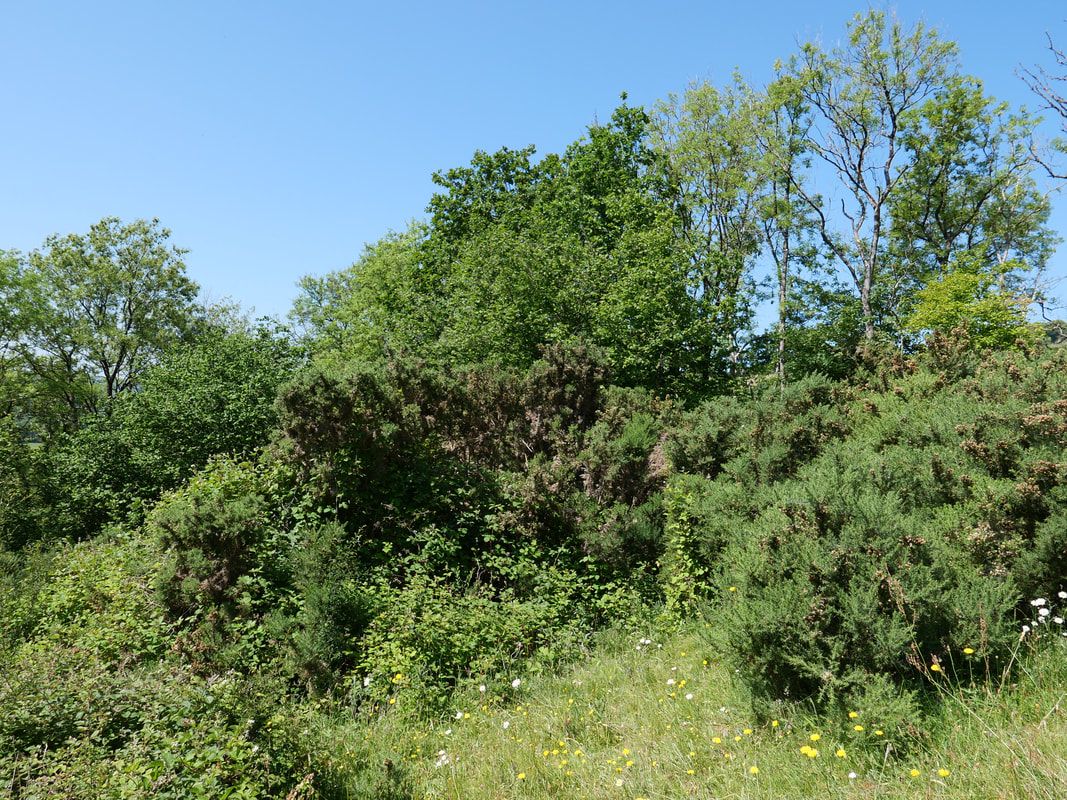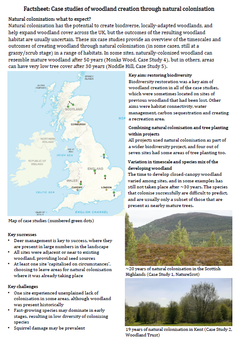Reflections following the Oxford Real Farming ConferenceBy Susannah Fleiss, University of Edinburgh. In early January, I attended the Oxford Real Farming Conference (ORFC), which has grown rapidly since its beginnings as a small gathering in 2010, this year welcoming 1,800 delegates in person. The majority of conference attendees are farmers interested in agro-ecology, producing food with nature at the heart of their farming systems. Such ‘land sharing’ systems, where nature and food production go hand-in-hand within a landscape, create and maintain many of the semi-natural and mixed habitats that represent and support much of the nature in Britain. We often hear that these systems would not succeed in ‘feeding the nation’, as a justification for unsustainable, intensive farming methods. But, with widespread dietary change to adapt our consumption to the products of this type of farming, we Britain could indeed feed itself through low-input, sustainable farming methods, whilst supporting biodiversity in the same landscapes [1]. Broadly speaking, the farmers who attend the ORFC are likely to be interested in supporting trees and woodland on their land, for a whole host of reasons. Yet, in spite of 19 parallel sessions running through the two-day event, there was very little that brought trees and woodlands into focus. To make up for this, here I take the opportunity to reflect on the question: how might natural colonisation fit into these farming systems? And alongside this question, perhaps – should it fit? In this blog post, I will bring together my thinking about natural colonisation, following the first year of working on this project (particularly in light of many interesting discussions with our Knowledge User Board and other stakeholders), alongside my own start as a small-scale farmer. What biodiversity does natural colonisation bring to farms and landscapes? Before musing on how natural colonisation could fit on farms, it would be useful to consider what it brings to a landscape. From our early project work bringing together some case studies of natural colonisation [2], it is clear that natural colonisation provides valuable habitat both in the early scrub stages (as at Noddle Hill, where succession has not yet progressed beyond scrub [3]), and once a closed canopy woodland begins to form (for example, at Monks Wood or Hucking Estate [4,5]). Woodland resulting from natural colonisation may have better ecological condition than planted woodland (such as through greater structural diversity, and greater resilience of the locally-adapted trees). In this blog, however, I mostly consider the early habitat phase of natural colonisation, as this is what farmers would be faced with first - and it can sometimes last for decades! As a starting point for understanding the biodiversity value of any particular habitat within our landscapes, I like to consider it from two perspectives: its equivalents both in prehistory and in traditional farming systems. It goes without saying that all prehistoric forest was formed through natural colonisation! Across much of Britain, it’s likely that scrub and open woodland would have formed part of the prehistoric ‘wildwood’ habitat mosaic, alongside closed-canopy woodland and grassland, following the lines of thought of Oliver Rackham and Frans Vera [6,7]. We don’t know what proportions of our prehistoric landscapes were occupied by these different habitat types, but judging by the extremely high levels of biodiversity supported by extensive scrub and young/open woodland habitat today, such as at Knepp Estate, these habitats would have played an important role in supporting a rich flora and fauna across wider landscapes [8,9]. Agriculture became widespread in Britain during the Neolithic period, and major changes to landscapes and biodiversity occurred. However, it wasn’t until the more recent transition from traditional, pre-industrial farming systems to industrialised farming that detrimental, pervasive biodiversity loss occurred in Britain – largely over the last 200 years, but particularly since 1950 or so. Traditionally-farmed landscapes produced food, fuel and fibre for their human inhabitants, whilst supporting biodiversity, so can today provide us with opportunities to explore how production and nature might go hand-in-hand. It is also worth remembering that standards of living pre-1700 were often far below what would be considered acceptable today, and the number of mouths to feed was much smaller (yet here I refer again to the Sustainable Food Trust’s report on feeding today’s Britain with sustainable local produce [1]). In traditionally-farmed landscapes, areas of scrub and heathland were used for firewood, other fuel collection, and common grazing (although many commons likely had higher grazing pressure historically than today, so perhaps would have been more open) [6]. Hedges were generally much taller, wider and denser than those of today, through necessity of being stock-proof, and provided linear scrub-like features across farmed landscapes. I also wonder to what extent coppice regrowth (previously so widespread across much of Britain) produced a habitat that was similar in ecological functioning to the scrub and young, open woodland that is formed in the early stages of natural colonisation. This undoubtedly only touches on a few of the historic roles of scrub and open woodland in landscapes… In comparison to the mixed landscapes of previous centuries, many of today’s landscapes in Britain are dominated by a few habitat types alone, often of low biodiversity value. Open woody habitats and scrub are largely missing in many areas, with many marginal habitat areas (such as previous heath and scrub patches) now farmed, and woodlands no longer coppiced. Field sizes have increased, thanks to the removal of hedgerows, and most hedges are cut back to short and narrow dimensions each year. In many places, this has resulted in a thorough removal of scrub and young, open woodland from our landscapes. Why might farmers want to create woodland through natural colonisation?
When creating woodland, farmers would have particular aims in mind – for example, producing firewood or timber, providing shelter for stock or crops, helping manage water in the landscape, supporting biodiversity on the farm, and/or (as of fairly recently) sequestering carbon. There are three particular difficulties with the idea of using natural colonisation rather than tree planting to create a woodland on a farm. Firstly, natural colonisation is a slow process, taking some decades to form a woodland. Secondly, the outcome cannot be predicted: sometimes trees don’t colonise, and if they do, the species mix can’t be guaranteed. Thirdly, it’s not clear what saleable goods (wood, timber and potentially other products) would be produced, nor quite how many generations it might take! However, natural colonisation can lead to the eventual creation of mixed-structure woodlands of locally-adapted trees. Of course, many ‘goods’ produced by habitats on farms are not saleable, but come in the form of ecological or environmental benefits. The initial scrub habitat formed by natural colonisation might support pollinators (particularly through flowering blackthorn and hawthorn), provide shelter and regulate the farm microclimate, help attract wildlife to the farm for natural pest control, or help keep unwanted wildlife separate from other areas of the farm. One farmer I know attributes his avoidance of bovine TB to 6m-wide hedges, which provide ample habitat for badgers and other transmitters to use without interacting with the cattle. Browse (fodder from woody shrubs/trees) has high nutritional value for livestock [10], so natural colonisation could provide sheltered areas for livestock to occupy and feed on (provided stocking were infrequent enough to allow the scrub and trees to develop). As interest in carbon sequestration grows, use of farmland to sequester carbon is becoming an increasingly hot topic. The capacity for natural colonisation to sequester carbon is unclear – certainly, areas of tree planting would store aboveground carbon (i.e. woody biomass) more quickly. However, the soil disturbance from tree planting can cause substantial carbon emissions, and the same may be true for natural colonisation, although perhaps to a lesser extent [11,12]. At this stage, it’s likely that supporting biodiversity and future resilient woodlands would be the main reasons for allowing natural colonisation, rather than carbon sequestration – but we’re eagerly awaiting more information in this field. Farmers (and other land managers) will have diverse opinions about when natural colonisation might be an appropriate use of land, which we will have much more information on once the results from the TreE PlaNat nationwide survey. There are a few key challenges that may crop up, such as the uncertainty of the outcomes of natural colonisation, and the ‘untidy’ appearance of scrub, which is not generally considered farmed land – what might the neighbours think?! Is the priority to establish a closed canopy woodland quickly? We look forward to knowing more about land managers’ preferences for different woodland creation methods as the project progresses. Where next? Are we asking too much of farmers? From observing the current round of consultations for Wales’ new Sustainable Farming Scheme, my feeling is that an awful lot is being asked of farmers here, and in other nations too. But, given our unprecedented circumstances of biodiversity and climate crises, poor national health, potential disruptions to long supply chains, and the urgent need to increase our consumption of local produce, this is probably to be expected. I would hope that amongst all these demands on land, the odd untidy corner will be allowed to do its thing on most farms. Other measures, such as improved hedgerow management, to encourage larger and denser hedges (saving costs and increasing shelter at the same time!), and potentially coppicing woodland (could we produce our own fence posts?), could also provide related biodiversity benefits. There are many disputes around the proposed eligibility criterion of 10% tree cover on ‘plantable’ areas of a farm for the upcoming Sustainable Farming Scheme (among a number of other requirements). This shows that good communication and messaging is key, and suddenly imposing requirements on farmers may not go down well. There are still lots of unknowns about the best ways to manage land for productivity and biodiversity, in the context of major changes to climate and society, and how to have constructive conversations around this. I look forward to continuing the discussion. CITED LITERATURE: [1] Sustainable Food Trust (2022) Feeding Britain From the Ground Up. [2] Fleiss, S. and TreE PlaNat Knowledge User Board. Factsheet: Case studies of woodland creation through natural colonisation. [3] Broughton et al. (2022) Slow development of woodland vegetation and bird communities during 33 years of passive rewilding in open farmland. PLOS ONE 17(11). [4] Broughton et al. 2021. Long-term woodland restoration on lowland farmland through passive rewilding. PLOS ONE. [5] Woodland Trust (2019) Hucking Estate Management Plan 2019-2024. [6] Rackham, O. (1986) The History of the Countryside. [7] Vera, F. (2000) Grazing Ecology and Forest History. [8] Tree, I. (2018) Wilding. Picador. [9] Mortimer et al. (2000) The Nature Conservation Value of Scrub in Britain. JNCC Report no. 308. [10] Agricology: Browse, preserved tree fodder and nutrition. [11] Friggens et al. (2020) Tree planting in organic soils does not result in net carbon sequestration on decadal timescales. Global Change Biology 26(9). [12] Street, L. and Housego, N. (2023) Presentation: Soil carbon, climate and land use. University of Edinburgh Forests and Landscapes Network event.
0 Comments
New resource available: collection of case-studies of woodland creation through natural colonisation By Susannah Fleiss, University of Edinburgh
How can landowners try something new, when little information is available? Stimulated by conversations among foresters, farmers, land agents and ecologists, the TreE PlaNat team have put together a number of case studies on woodland creation through natural colonisation to address this issue. When creating woodland, land managers (such as farmers, foresters, estate owners and their land agents) usually plant trees, designing the planting scheme according to their local context, reasons for creating the woodland, planned uses, and desired species. However, allowing trees to establish through natural processes can create locally-adapted, resilient woodlands, of high biodiversity value [1]. When creating woodland through ‘natural colonisation’, seedlings germinate from local seed sources that arrive at the site naturally, some of which survive and develop into trees. A key difficulty for land managers is that the outcome of this process is not guaranteed: it is very difficult to predict the timeframe it takes to create a closed-canopy woodland, and the species which will colonise the area and survive [2,3,4]. Our project, TreE PlaNat (Treescape Expansion through Planting and Natural colonisation), is examining how, where and for whom natural colonisation might be used to create new woodlands, including in combination with tree planting. As part of this project, researchers at the University of Edinburgh are facilitating a ‘Knowledge User Board’ of land managers, who provide feedback on the research directions and findings, and help guide the project to produce useful outputs for those working on the ground. Early in the project, the group highlighted the importance of having case studies to provide land managers with examples and basic knowledge to consider using natural colonisation to create woodland. In a collaborative effort with the Knowledge User Board, we created a collection of case studies and one-page summary factsheet, available through the Edinburgh Research Archive and the TreE PlaNat website. |
AuthorsLaura Braunholtz, Ecology post-doc, University of Stirling Categories
All
|



 RSS Feed
RSS Feed